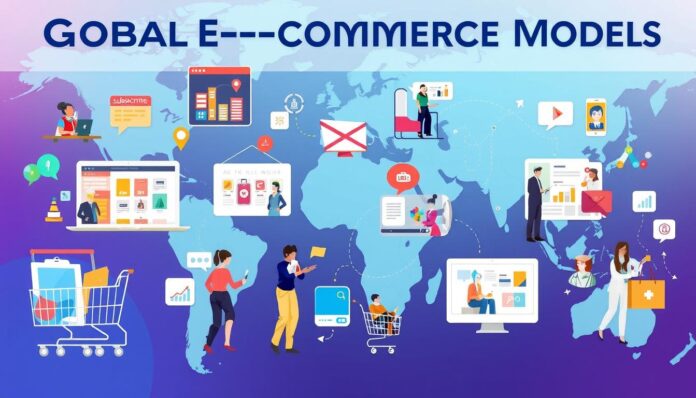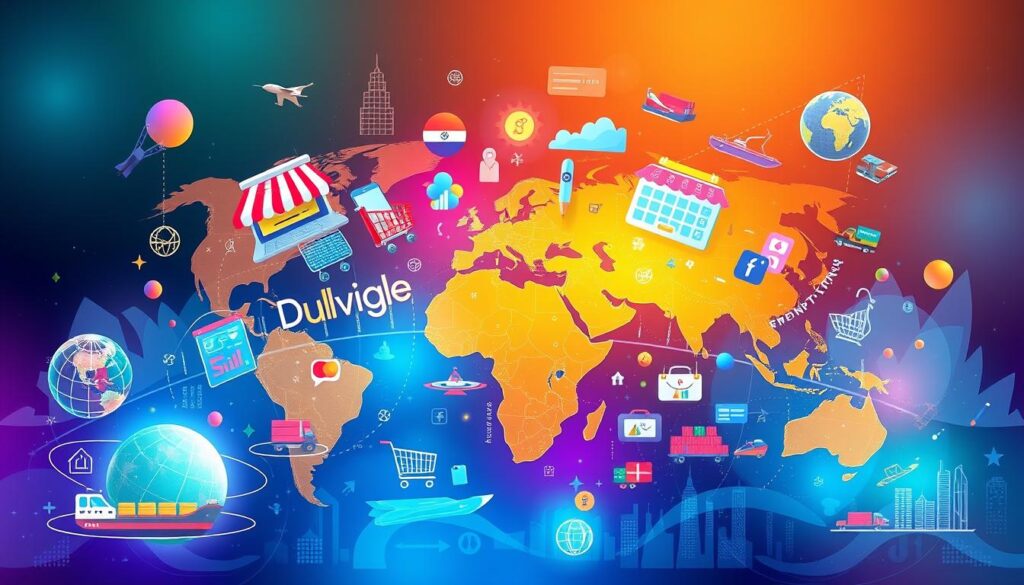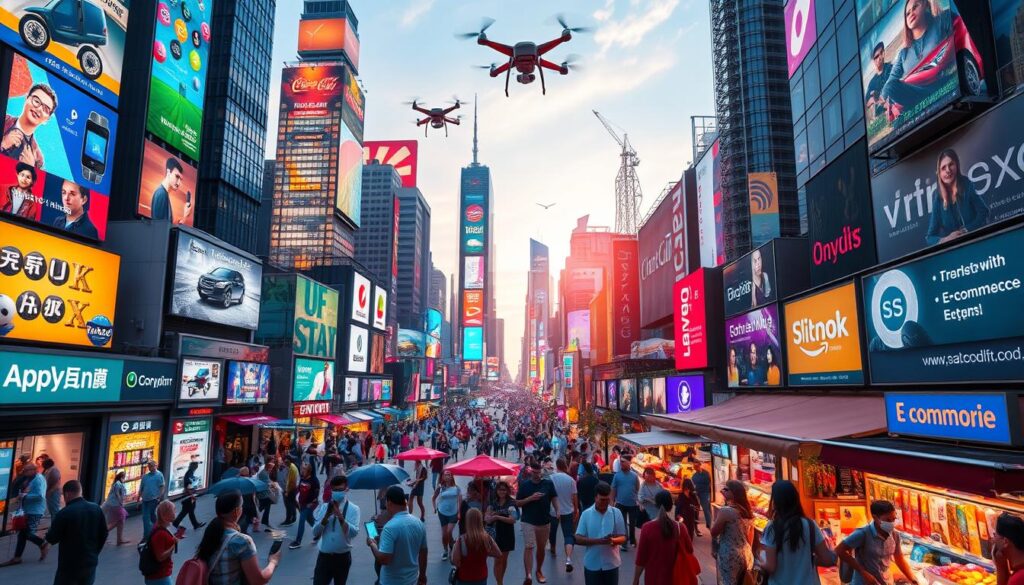Ever wondered how top online stores succeed globally? The e-commerce world is changing fast. Now, using the best global e-commerce models is key. These models help meet different customer needs and boost sales across borders, shaping the future of online shopping.
In this article, we’ll look at the main global e-commerce models. These include Business-to-Consumer (B2C) and Consumer-to-Consumer (C2C) models. Each has its own strengths and challenges for success in today’s digital market. Let’s dive into the details and find out how businesses can succeed in this competitive space.
Table of Contents
Key Takeaways
- The B2C model is the most common, sticking to traditional retail ways.
- New trends like dropshipping show promise for low-cost e-commerce.
- Subscription models are growing, giving customers convenience and savings.
- C2C platforms connect people, often through fees.
- Millennials are now a big part of B2B buying, showing a shift in who’s spending.
Introduction to E-Commerce Models
E-commerce models are the ways businesses sell online. Knowing these models helps in making good e-commerce plans. Each model meets different customer needs, changing how we shop.
The main e-commerce models are B2C, B2B, B2G, C2C, C2B, and C2G. Each has its own features and ways to make money. They offer many ways to shop online.
B2C companies have quick sales, lots of transactions, and small average sales. They make money through dropshipping, subscriptions, and selling used items. B2B deals are longer, with bigger sales and repeat buys. They often use subscriptions and white labeling.
B2G deals are big and follow strict rules. C2C sites let people sell to each other, handling quality and payments. C2B lets consumers sell to businesses, making the market more flexible. C2G makes buying from government easier and more competitive.
Good e-commerce plans use SEO for visibility and PPC for targeted ads. PPC helps control costs and gets quick results. By mid-2024, online retail was 16% of all sales, showing its big role today.
| E-Commerce Model | Characteristics | Common Revenue Models |
|---|---|---|
| B2C | Short sales cycle, high transaction volume | Dropshipping, subscriptions |
| B2B | Longer sales cycle, higher transaction value | White labeling, subscriptions |
| B2G | High transaction values, compliance-focused | Contracts, grants |
| C2C | Peer-to-peer transactions | Commissions, listing fees |
| C2B | Consumers selling to businesses | Content sales, service offerings |
| C2G | Administrative ease, competitive opportunities | Taxes, civic services |
Understanding the Rise of E-Commerce
E-commerce has changed the retail world a lot in recent years. In 2023, online sales made up over 19% of all retail sales worldwide. Experts predict that by 2025, online sales will be nearly 22% of all retail in the U.S.
Many things have helped e-commerce grow. More people can now use the internet, with over five billion online today. This growth is seen in the expected 39% increase in global online sales, reaching over $8 trillion by 2027. Mobile shopping is also on the rise, with sales expected to hit $728.28 billion by 2025.
People’s shopping habits have changed a lot too. Now, they like the ease of online shopping. This has made big names like Amazon very popular. In 2023, Amazon was the top choice for online shopping, with over 150 million Prime members.
Technology has also been key in e-commerce’s growth. Businesses are using new models like Direct-to-Consumer (DTC) and Consumer-to-Consumer (C2C). Platforms like Shopify are popular, used by about 80% of e-commerce brands worldwide.
In summary, e-commerce’s growth comes from both consumer demand and new tech. The industry keeps growing, thanks to strong sales numbers and a shift towards online shopping.
Also, using affiliate marketing can help increase sales. Over 81% of brands use it to make more money.
Popular Global E-Commerce Models
The world of e-commerce is full of different models. Each one meets different needs and goals. Knowing these models helps us move smoothly through the digital market.
Some of the most well-known e-commerce models are:
- Business-to-Consumer (B2C): This model is about businesses selling to people. Sites like Amazon are great examples. They let people buy lots of things directly from companies.
- Business-to-Business (B2B): This model is for companies selling to other companies. It’s common in wholesale deals. It helps businesses buy in bulk and save money.
- Consumer-to-Consumer (C2C): In this model, people sell to other people. eBay is a good example. It lets people trade goods and services without needing a middleman.
- Consumer-to-Business (C2B): This model is growing. It’s about individuals selling to companies. It shows a change in how we do business.
- Dropshipping: This method is great for starting small. It lets sellers sell products without keeping any stock. It works well in both B2B and B2C settings.
- Physical Retail: This is the old-school way of shopping. It’s about going to stores and talking to people. It helps build strong relationships with customers.
- Manufacturing: This model is about making products. It can be either private label or white label. It’s good for quality, but scaling up can be hard.
- Multi-Vendor Platforms: Sites like Amazon and Etsy are examples. They let many sellers work together. Everyone shares the profits and gets help with running their business.
Online shopping is getting bigger and bigger. By 2025, it’s expected to be almost a quarter of all retail sales. In 2021, over 2 billion people shopped online. That added up to about $5 trillion in sales.
As we explore these models, we see they all have their own strengths. They offer many chances for businesses and shoppers to succeed.
Business-to-Consumer (B2C) Model
The Business-to-Consumer (B2C) model is key in e-commerce, linking businesses straight to users. It has special traits that set it apart from other e-commerce types. Knowing these traits is vital for businesses aiming to thrive in this competitive field. As global retail revenues in B2C e-commerce are set to grow, understanding these traits is more important than ever.
Characteristics of B2C
The B2C model has a shorter sales cycle than B2B, leading to lower marketing costs. This encourages quick buying decisions by consumers. It also allows for a direct link between retailers and customers, helping build loyalty and trust.
- Shorter Sales Cycles: B2C transactions often complete faster than B2B sales.
- Lower Marketing Costs: Direct-to-consumer relationships reduce intermediary expenses.
- Recurring Orders: Successful brands commonly see repeat purchases from satisfied customers.
- Subscription Services: B2C has embraced subscription models for convenience.
- High Cart Abandonment: Approximately 70.19% of shoppers leave items in their carts.
For more insights on effective strategies for boosting sales in the B2C model, check this relevant article.
Examples of Successful B2C Brands
Several B2C brands show the model’s power and effectiveness. Amazon and Alibaba have changed online shopping with their platforms. Amazon focuses on the customer, with fast delivery and a wide range of products, leading to big revenue growth. Alibaba serves both local and international customers, helping small businesses grow.
Other brands like Saddleback Leather Company and The Good and The Beautiful have also seen success. Saddleback Leather Company’s revenue jumped 43% after improving its website. The Good and The Beautiful tripled their sales during the pandemic.
Successful B2C brands quickly adapt to changing consumer habits. They use new strategies to stay ahead. This shows how vital it is to grasp the B2C model’s traits for lasting growth and customer happiness in e-commerce.
Business-to-Business (B2B) Model
The Business-to-Business (B2B) model is key in the global economy. It deals with transactions between organizations. We’ll look at its features and examples from different industries.
Key Features of B2B
The B2B model has unique features. It has longer sales cycles because of complex decision-making. Transactions are often bigger, leading to strong supplier-customer ties. Suppliers also focus on long-term relationships, boosting loyalty.
- Higher average deal size compared to B2C transactions
- Longer and more structured buying processes involving multiple stakeholders
- Effective use of e-commerce tools for efficient procurement and supply chain management
- Diverse marketing strategies including SEO, content marketing, and account-based marketing
- Ability to cater to niche markets with customized solutions
Industry Examples and Case Studies
Let’s see how the B2B model works in different industries. Tech, finance, and manufacturing use B2B strategies to connect and improve operations.
| Industry | Company | Strategy |
|---|---|---|
| Technology | Salesforce | Cloud-based CRM solutions enhance client relationships and sales processes |
| Manufacturing | General Electric | JIT purchasing keeps inventory low and cuts costs |
| Financial Services | PayPal | Secure financial transactions between businesses |
| Telecommunications | AT&T | Custom communication solutions for businesses |
Looking at these B2B industry examples, we see the benefits of online tools. They help with procurement, customer service, and marketing. The North American B2B eCommerce market is expected to grow to over $4,600 billion by 2025, showing the model’s importance.
Business-to-Government (B2G) Model
The Business-to-Government (B2G) model is a key part of e-commerce. It involves businesses selling goods and services to government bodies. Understanding business-to-government transactions is complex. By May 2024, the federal government had spent over $3.8 trillion, showing how important B2G is.
Companies aiming to succeed in B2G must deal with a detailed bidding process. This starts with requests for proposals (RFPs). These RFPs outline what the government needs, allowing suppliers to bid competitively. The need for strict compliance and transparency can be a challenge, making specialized strategies vital.
Stable contracts are common in B2G, with a focus on small businesses. Governments aim to use a certain percentage of funds for them. This helps smaller businesses, including those owned by veterans, women, and minorities, compete for contracts.
As e-commerce grows, understanding the B2G model becomes more important. By 2024, e-commerce is expected to make up nearly 20% of all retail sales worldwide. Knowing this market helps businesses build strong partnerships with government bodies, boosting their role in e-commerce.
Consumer-to-Consumer (C2C) Model
The Consumer-to-Consumer (C2C) model has changed how people shop online. It lets buyers and sellers meet and trade directly. Sites like eBay, Etsy, and Amazon Marketplace make it easy for people to sell things without spending a lot.
These platforms make money by charging for listings and transactions. They help users by connecting them and making it easy to buy and sell.
Understanding C2C Platforms
C2C platforms offer different ways to buy and sell. Some have auctions, while others have fixed prices. You can bid on items or buy them right away.
More people are using these platforms because they are affordable. Social media helps bring more traffic. Etsy, for example, gives sellers tools to grow their businesses.
Challenges and Opportunities in C2C
The C2C model has its ups and downs. It lacks quality control and payment safety. But, PayPal and other systems help make transactions secure.
Sellers use C2C platforms to find unique customers. They don’t need to store or ship products. This saves money and makes it easier to start selling.
C2C platforms are great for both buyers and sellers. They offer a wide range of products at good prices. But, finding the right platform can be hard.
Platforms like Clarity eCommerce offer solutions for different needs. The trend of targeting specific markets shows the demand for good C2C platforms. This highlights the need for custom solutions in this fast-changing world.
Consumer-to-Business (C2B) Model
The Consumer-to-Business (C2B) model is changing the e-commerce world. It lets people sell things or services to businesses. This is a big change from the old way of business-to-consumer sales.
Platforms like Upwork show how the C2B model works. They connect people with businesses that need specific skills. This lets people make money from their talents in writing, design, and coding.
More than a third of U.S. workers are now in the gig economy. This shows how important C2B transactions are today.
In the C2B world, everyone wins. Businesses get access to a wide range of skills. People can use their talents without being stuck in a regular job. This helps everyone be more creative and flexible.
Companies also learn a lot from consumers. They get feedback that helps improve their products and services. This feedback can make marketing better and help brands grow.
Using influencers and affiliate marketers can also help businesses. When people recommend products or show ads, they make money. This fits well with the C2B model’s idea of working together.
Global E-Commerce Models and Their Impact on Cross-Border Trade
The rise of global e-commerce models has changed cross-border trade a lot. Now, one-third of all e-commerce is across borders. This shows how businesses are reaching out to new markets.
This growth is more than just numbers. It shows how companies are now part of global retail solutions. They can now access revenue streams they couldn’t before.
As we move forward, efficient and affordable logistics are key. With more cross-border e-commerce, companies need to adjust their supply chains. They face complex rules and laws in different countries.
Dealing with these rules can slow growth. So, it’s important to find ways to overcome these challenges.
Also, we can’t ignore the cybersecurity risks in cross-border e-commerce. As more transactions happen, so does the chance for fraud and security breaches. So, strong security measures are vital to protect data.
In short, e-commerce models do more than just help with transactions. They change how we think about international trade, logistics, and trust in a global economy.
FAQ
What are the different global e-commerce models?
There are several global e-commerce models. These include Business-to-Consumer (B2C), Business-to-Business (B2B), and more. Each model meets different needs in the online shopping world.
How do e-commerce strategies impact international online retail?
Good e-commerce strategies are key for online retail worldwide. They help businesses deal with the challenges of selling across borders. They also help businesses meet the needs of different markets and reach more customers.
Why is understanding online commerce trends important for businesses?
Knowing the trends in online commerce helps businesses stay ahead. It lets them see what customers want and change their strategies to meet those needs. This way, they can offer a better shopping experience.
What advantages does the B2C model offer?
The B2C model has many benefits. It allows for quick sales, direct contact with customers, and personalized marketing. Big names like Amazon and Alibaba have used these to change how we shop online.
What are the unique characteristics of the B2B model?
The B2B model is different because it involves longer sales and bigger orders. It also focuses on building long-term relationships. Businesses need special strategies to handle these big deals well.
How does the B2G model operate?
The B2G model is about selling to governments. It follows strict rules and bidding processes. Businesses must meet these requirements to win government contracts.
What are the benefits and challenges of C2C platforms?
C2C platforms like eBay let people sell to each other. They offer low costs and a wide range of products. But, they also face issues like ensuring product quality and keeping the platform reliable.
How does the C2B model empower consumers?
The C2B model lets consumers sell to businesses. It helps them make money from their skills or goods. Sites like Upwork are examples, connecting people with businesses that need their expertise.
In what ways do global e-commerce models influence cross-border trade?
Global e-commerce models help businesses sell across borders. They need to think about logistics, rules, and marketing to succeed. This way, they can offer products worldwide.






